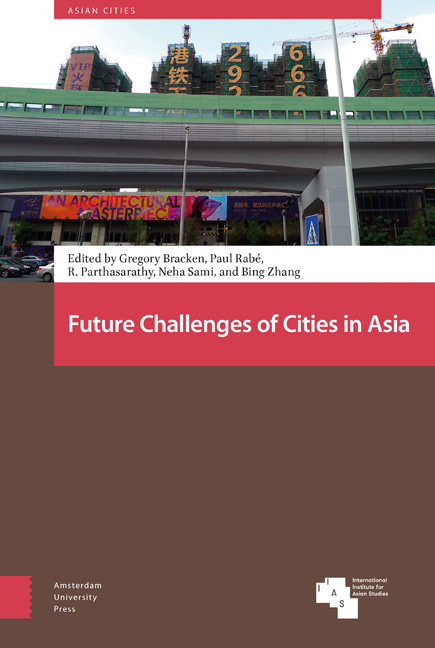Book contents
- Frontmatter
- About the Three UKNA Volumes
- Contents
- List of Figures and Tables
- 1 Future Challenges of Cities in Asia: An Introduction
- 2 Human Agency in the Asian City
- 3 Toward Inclusive, Vital and Livable City Scenarios: The Transformation of Urban Villages in Shenzhen
- 4 Cultural Dilemma in Beijing's Urban Regeneration: From Liulichang Cultural Street to Qianmen Street and Yangmeizhu Oblique Street
- 5 Housing as Heritage: The Great Urban Dilemma of the Global City of Shanghai
- 6 Not an Act of God: Lessons from a Disaster in the Settlements Planning of a River City
- 7 The Political Ecology of Climate Injustice in Bangkok
- 8 Assessing Flood-Related Vulnerability of the Urban Poor
- 9 The Ecological Future of Cities: Evaluating the Role of Green Infrastructure in Promoting Sustainability/Resilience in India
- 10 Hong Kong's “Rail-plus-Property” Development: A Model for Financing Public Transportation in Developing Cities in Southeast Asia?
- 11 Large Infrastructure Projects: The Emergence of Corridors in Asia
- Index
- Publications / Asian Cities
10 - Hong Kong's “Rail-plus-Property” Development: A Model for Financing Public Transportation in Developing Cities in Southeast Asia?
Published online by Cambridge University Press: 21 November 2020
- Frontmatter
- About the Three UKNA Volumes
- Contents
- List of Figures and Tables
- 1 Future Challenges of Cities in Asia: An Introduction
- 2 Human Agency in the Asian City
- 3 Toward Inclusive, Vital and Livable City Scenarios: The Transformation of Urban Villages in Shenzhen
- 4 Cultural Dilemma in Beijing's Urban Regeneration: From Liulichang Cultural Street to Qianmen Street and Yangmeizhu Oblique Street
- 5 Housing as Heritage: The Great Urban Dilemma of the Global City of Shanghai
- 6 Not an Act of God: Lessons from a Disaster in the Settlements Planning of a River City
- 7 The Political Ecology of Climate Injustice in Bangkok
- 8 Assessing Flood-Related Vulnerability of the Urban Poor
- 9 The Ecological Future of Cities: Evaluating the Role of Green Infrastructure in Promoting Sustainability/Resilience in India
- 10 Hong Kong's “Rail-plus-Property” Development: A Model for Financing Public Transportation in Developing Cities in Southeast Asia?
- 11 Large Infrastructure Projects: The Emergence of Corridors in Asia
- Index
- Publications / Asian Cities
Summary
Abstract
Many Southeast Asian developing cities are facing traffic and pollution issues. In order to produce a more sustainable city, local governments often opt for developing modern public transit systems. Because of a lack of finance, developing cities are supported by international donors while also looking for self-sufficient financing approaches like land value capture mechanisms. The Hong Kong “Rail plus Property” (R+P) model is seen as a reference. This chapter stresses the advantages of such a model, points out the particularities that make this model very unique and argues that adjustments that have recently been made are distorting the original model. Hence, the R+P model appears not as evident and straightforward as its advocates would like it to be.
Keywords: land value capture, urban policy transfer, public transportation, Hong Kong
Due to their economic takeoff and the rapid pace of urbanization, Southeast Asian developing cities like Hanoi, Ho Chi Minh City, Phnom Penh, and Vientiane saw the number of private vehicles – first motorcycles and then cars – on their streets increasing tremendously. Thus, now they face severe traffic congestion. To address this critical issue, local governments often apply two main remedies. On the one hand, they build new roads, which satisfies the emerging middle class which can afford to buy cars, without seriously taking into account the negative environmental impacts. On the other hand, they try to modernize public transit networks, especially by constructing mass rapid transit systems that operate metros, buses, or light-rail trains on exclusive rights-of-way. But the development of these infrastructures is impeded by a serious lack of financial resources. In general, international development banks and agencies provide grants and loans to fund these costly megaprojects. Partnerships between public and private sectors are also seen as an option to build and operate these facilities. However, few cities seek a self-sufficient financing approach to establish and run a modern public transit network.
In terms of planning, financing, building, and operating an urban rail system, with its integrated “Rail plus Property” (R+P) model, Hong Kong is frequently seen as an example in Asia. The model is based on a “value capture” scheme, in which the Hong Kong government provides land rights to the railway operator, the Mass Transit Railway Corporation (MTRC).
- Type
- Chapter
- Information
- Future Challenges of Cities in Asia , pp. 243 - 276Publisher: Amsterdam University PressPrint publication year: 2019

